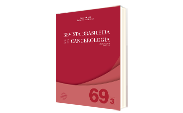Photobiomodulation in Stevens-Johnson Syndrome in a Metastatic Breast Cancer: Case Report
DOI:
https://doi.org/10.32635/2176-9745.RBC.2023v69n3.4148Keywords:
Stevens-Johnson syndrome, low-Level light therapy, breast neoplasms, physical therapy specialtyAbstract
Introduction: Stevens-Johnson syndrome is a rare but potentially fatal condition, which requires early diagnosis and treatment to ensure good prognosis. Due to the complexity of the syndrome and the lack of a standard wound care treatment, the use of photobiomodulation has been discussed. Case report: A 30-year-old woman with metastatic breast cancer and Stevens-Johnson and Li-Fraumeni Like syndromes using photobiomodulation as an adjuvant strategy in the treatment of pain and skin wounds. The erythematous cutaneous lesions involved almost the entire body surface with painful, scaly, crusted and bullous lesions with bleeding spots in the posterior region of both ears lobes and in the occipital region which made it difficult to accommodate the patient in lateral decubitus and in semi-recumbent position. Two photobiomodulation applications (red, with a wavelength of 660 nm) were performed, where lesions in the occipital region and ears were treated with a dose of 2 Joules per point and 4 Joules in the scapular region for pain relief (infrared, with a wavelength of 808 nm), followed by mobilization and myofascial release in the scapular region. In 48 hours, the cutaneous lesions reduced, and the pain improved, which facilitated the adequate and painless positioning in bed. After 15 physiotherapy sessions, the patient was discharged. Conclusion: Photobiomodulation has been shown to be effective in the complementary treatment of the acute phase of Stevens-Johnson Syndrome regarding tissue regeneration and analgesia.
Downloads
References
Lin CC, Chen CB, Wang CW, et al. Stevens-Johnson syndrome and toxic epidermal necrolysis: risk factors, causality assessment and potential prevention strategies. Expert Rev Clin Immunol. 2020;16(4):373-87. doi: https://doi.org/10.1080/1744666X.2020.1740591 DOI: https://doi.org/10.1080/1744666X.2020.1740591
Lerch M, Mainetti C, Beretta-Piccoli BT, et al. Current perspectives on Stevens-Johnson syndrome and toxic epidermal necrolysis. Clin Rev Allergy Immunol. 2018;54(1):147-76. doi: https://doi.org/10.1007/s12016-017-8654-z DOI: https://doi.org/10.1007/s12016-017-8654-z
Papp A, Sikora S, Evans M, et al. Treatment of toxic epidermal necrolysis by a multidisciplinary team. A review of literature and treatment results. Burns. 2018;44(4):807-15. doi: https://doi.org/10.1016/j.burns.2017.10.022 DOI: https://doi.org/10.1016/j.burns.2017.10.022
Bay C, Vissing AC, Thaysen-Petersen D, et al. Skin reactions after photodynamic therapy are unaffected by 839 nm photobiomodulation therapy: a randomized, double-blind, placebo-controlled, clinical trial. Lasers Surg Med. 2017;49(9):810-8. doi: https://doi.org/10.1002/lsm.22690 DOI: https://doi.org/10.1002/lsm.22690
Cartotto R. Burn Center Care of Patients with Stevens-Johnson syndrome and toxic epidermal necrolysis. Clin Plast Surg. 2017;44(3):583-95. doi: https://doi.org/10.1016/j.cps.2017.02.016 DOI: https://doi.org/10.1016/j.cps.2017.02.016
Fallah A, Mirzaei A, Gutknecht N, et al. Clinical effectiveness of low-level laser treatment on peripheral somatosensory neuropathy. Lasers Med Sci. 2017; 32(3):721-8. doi: https://doi.org/10.1007/s10103-016-2137-y DOI: https://doi.org/10.1007/s10103-016-2137-y
Heiskanen V, Hamblin MR. Photobiomodulation: lasers vs. light emitting diodes? Photochem Photobiol Sci. 2018;17(8):1003-17. doi: https://doi.org/10.1039/c8pp90049c DOI: https://doi.org/10.1039/c8pp00176f
Zecha JAEM, Raber-Durlacher JE, Nair RG, et al. Low level laser therapy/photobiomodulation in the management of side effects of chemoradiation therapy in head and neck cancer: part 1: mechanisms of action, dosimetric, and safety considerations. Support Care Cancer. 2016;24(6):2781-92. doi: https://doi.org/10.1007/s00520-016-3152-z DOI: https://doi.org/10.1007/s00520-016-3152-z
Rocha SR, Ferreira SAC, Ramalho A, et al. Photobiomodulation therapy in the prevention and treatment of radiodermatitis in breast cancer patients: systematic review. J Lasers Med Sci. 2022;(13):e42. doi: https://doi.org/10.34172/jlms.2022.42 DOI: https://doi.org/10.34172/jlms.2022.42
Wang Y, Ge Y, Xing W, et al. The effectiveness and safety of low-level laser therapy on breast cancer-related lymphedema: an overview and update of systematic reviews. Lasers Med Sci. 2022;37(3):1389-413. doi: https://doi.org/10.1007/s10103-021-03446-3 DOI: https://doi.org/10.1007/s10103-021-03446-3
Paglioni MP, Araújo ALD, Arboleda LPA, et al. Tumor safety and side effects of photobiomodulation therapy used for prevention and management of cancer treatment toxicities. A systematic review. Oral Oncol. 2019;(93):21-8. doi: https://doi.org/10.1016/j.oraloncology.2019.04.004 DOI: https://doi.org/10.1016/j.oraloncology.2019.04.004
Conselho Nacional de Saúde (BR). Resolução n° 466, de 12 de dezembro de 2012. Aprova as diretrizes e normas regulamentadoras de pesquisas envolvendo seres humanos [Internet]. Diário Oficial da União, Brasília, DF. 2013 jun 13 [acesso 2023 ago 2]; Seção I:59. Disponível em: https://bvsms.saude.gov.br/bvs/saudelegis/cns/2013/res0466_12_12_2012.html
Andrade RC. Caracterização molecular de pacientes com suspeita clínica de síndrome de Li-Fraumeni e Li-Fraumeni like [tese na Internet]. Rio de Janeiro: Instituto Nacional de Câncer; 2016 [acesso 2023 mar 20]. Disponível em: https://docs.bvsalud.org/biblioref/coleciona-sus/2016/36016/36016-1385.pdf
Freitas LF, Hamblin MR. Proposed mechanisms of photobiomodulation or low-level light therapy. IEEE J Sel Top Quantum Electron. 2016;22(3):1-37. doi: https://doi.org/10.1109/JSTQE.2016.2561201 DOI: https://doi.org/10.1109/JSTQE.2016.2561201
Jadhav P, Rogers JE, Shroff R. A case report - Stevens-Johnson syndrome as an adverse effect of capecitabine. J Gastrointest Cancer. 2018;49(3):349-50. doi: https://doi.org/10.1007/s12029-016-9916-3 DOI: https://doi.org/10.1007/s12029-016-9916-3
Simões A, Freitas PM, Bello-Silva MS, et al. Laser phototherapy for Stevens-Johnson syndrome: a case report. Photomed Laser Surg. 2011;29(1):67-9. doi: https://doi.org/10.1089/pho.2009.2671 DOI: https://doi.org/10.1089/pho.2009.2671
Rocha BA, Melo Filho MR, Santos LAN, et al. Terapia de fotobiomodulação no tratamento das lesões orais da síndrome de Stevens-Johnson: relato de caso. HU Rev. 2019;45(4):478-82. doi: https://doi.org/10.34019/1982-8047.2019.v45.25799 DOI: https://doi.org/10.34019/1982-8047.2019.v45.25799
Broughton G, Janis JE, Attinger CE. The basic science of wound healing. Plast Reconstr Surg. 2006;117(7Suppl.):12-34. doi: https://doi.org/10.1097/01.prs.0000225430.42531.c2 DOI: https://doi.org/10.1097/01.prs.0000225430.42531.c2
Rezende LF, Costa ECS, Lenzi J, et al. Transcutaneous electrical stimulation, interferential current and photobiomodulation may lead to the recurrence of breast cancer in rats? Rev Bras Cancerol. 2022;68(3):e-022383. doi: https://doi.org/10.32635/2176-9745.RBC.2022v68n3.2383 DOI: https://doi.org/10.32635/2176-9745.RBC.2022v68n3.2383
Brandão TB, Morais-Faria K, Ribeiro ACP, et al. Locally advanced oral squamous cell carcinoma patients treated with photobiomodulation for prevention of oral mucositis: retrospective outcomes and safety analyses. Support Care Cancer. 2018;26(7):2417-23. doi: https://doi.org/10.1007/s00520-018-4046-z DOI: https://doi.org/10.1007/s00520-018-4046-z
Published
How to Cite
Issue
Section
License
Os direitos morais e intelectuais dos artigos pertencem aos respectivos autores, que concedem à RBC o direito de publicação.

This work is licensed under a Creative Commons Attribution 4.0 International License.









